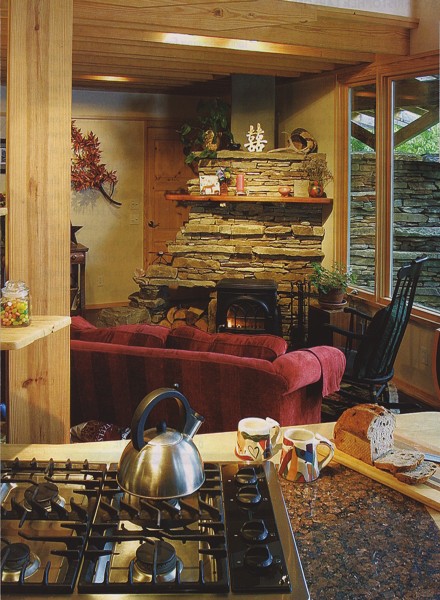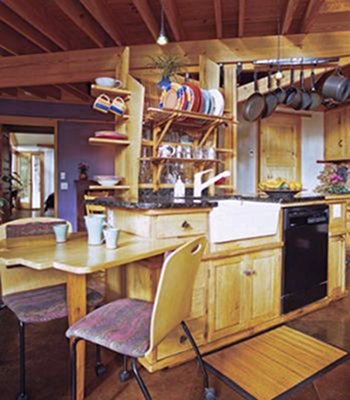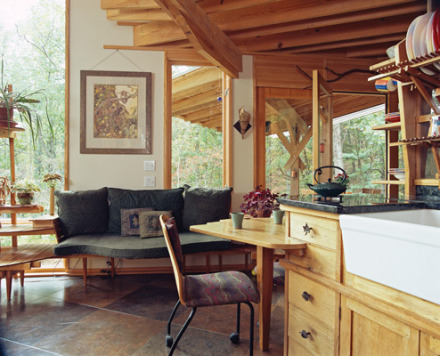The Sociable Kitchen
As the old saying goes: “No matter where I serve my guests, they like the kitchen best.” When I was 19, my father designed and built a remarkable house for our family, with a 12-foot-diameter octagonal spa/water feature at its center, a sunken living room with lofty ceilings, and an open dining room with heavy wooden table and chairs from Mexico. The kitchen was unusual in that not quite in the kitchen, but not entirely outside of it either, were a table and chairs for informal dining and a comfy love seat and overstuffed chair. Even with the spectacular features in the rest of the house, 90 percent of the activity took place in 10 percent of the area: in and around the kitchen.
People are attracted to kitchens like no other room in the house. They will leave the cushy living room sofas behind and stand and talk for long periods in kitchens of almost any description. So, if folks are that determined to hang out in the kitchen, why not give them a great place to do it?
Over the years as an inhabitant, observer, and architect of houses, I have been interested in exploring the concept of the kitchen as the hearth and heart of the home, especially in terms of the principles behind this everyone-wants-to-be-in-the-kitchen phenomenon. My Sociable Kitchen design is an evolving effort to identify why kitchens already are sociable places and how they can intentionally be made more so for the enjoyment and benefit of those who inhabit them.
Space, View and Light
A recent trend in kitchen design has been to eliminate or reduce the number of upper cabinets, allowing for more natural light, views, and greater connection to adjacent interior space. Taking this as a starting place, the Sociable Kitchen is not enclosed by any walls, but is part of a continuous “living landscape,” through which space, view, and light flow freely. Two islands, one for the range and one for the sink, define the work areas. Storage “screens” of varying densities attach to the back sides of these islands; they help create a feeling of kitchen, keep everyday stuff handy, visually block some of the clutter, and present a more formal face to the adjoining rooms. Instead of looking out a window over the sink, in the Sociable Kitchen you look across open space to windows and the view beyond. The fireplace is easily visible from and adds to the warmth of the kitchen.
 Photograph by Charles Miller, Fine Homebuilding magazine © 2002, The Taunton Press, Inc.
Photograph by Charles Miller, Fine Homebuilding magazine © 2002, The Taunton Press, Inc.
The Countertop Principle
People love to lean on countertops. In watching how people (other than the cook) relate to kitchens, I’ve observed that the most common posture is with one hip leaning into the countertop, one hand on the countertop and the other on the waist, and one foot carrying most of the weight. Try it and see if it doesn’t feel familiar. People love to linger and chat in this position, or an alternative version, with arms folded.
Countertops are powerful people magnets: the number of conversations that take place near countertops is astounding. A countertop conversation requires no commitment—all options are open for staying or moving on—and both a comfortable social distance and eye contact are easy to maintain. The Countertop Principle can be found at the office too, usually in the water and coffee area where spontaneous conversations occur as coworkers drop by. (Columns in open space are similar to countertops in they offer places to lean and thus can function as social catalysts as well.) The Sociable Kitchen has many not-in-the-way-but-still-in-the-kitchen places to lean and chat.
The French Café Principle
People love to hang out where the action is, to be part of what’s going on. Since the kitchen contains the refrigerator, it is by definition, where the action is. Unlike our four-legged housemates, who like being underfoot at inopportune times, people want to  photo: gil stosebe close enough to sense the energy of what’s happening, but off to one side and with a good view. This is the French Café Principle: small tables next to busy places.
photo: gil stosebe close enough to sense the energy of what’s happening, but off to one side and with a good view. This is the French Café Principle: small tables next to busy places.
In the Sociable Kitchen, the range and sink islands are splayed slightly, opening the space at one end for the placement of a small table to seat three or four people. This is where most quick meals take place. It’s a highly convenient arrangement, and convenience is a major factor in sociability. The small table is a great place for a kid to sit and do homework, with ready assistance from the cook as needed. It’s also a good spot for chopping when the cook wants help, and much more. The height of this table is the height of a regular table, so comfortable feet-on-the-floor chairs can be used to encourage lingering.
The Sociable Distance Principle
If you keep an eye on yourself and others through the course of a day, it’s easy to discover that conversations tend to take place when people are at arm’s length and eye level with each other. People wanting to speak to each other will usually move closer until these conditions are met. The proximity and height equality seems to guarantee undivided attention in both directions. At tables, arm’s length distance is easily maintained, social energies are contained, and conversation can be lively. Living rooms are different: sitting on sofas and chairs is less effective in maintaining the optimal social distance and fostering exchanges. As the distance between people increases, it’s easier for attention to wander away from relating to those around. Like most people, I suspect, I feel a bit disappointed when dinner guests are shooed from sitting around the dining room table into the living room—the connections among people are just not the same.  photo: gil stoseThe Sociable Kitchen is completed with the addition of a window seat or sofa. This soft place to sit adjacent to the Sociable Table caps the open end of the splayed counters. Thus there are both a small dining area and a living area as parts of the kitchen, allowing people to relate to the energy of the kitchen activity and to each other in many different ways without being in the way. When mixed all together—countertops for leaning, comfy places to sit, easy social distances, and the attraction and convenience of being in the kitchen—things happen: conversations are spontaneous, and people actively engage with one another.
photo: gil stoseThe Sociable Kitchen is completed with the addition of a window seat or sofa. This soft place to sit adjacent to the Sociable Table caps the open end of the splayed counters. Thus there are both a small dining area and a living area as parts of the kitchen, allowing people to relate to the energy of the kitchen activity and to each other in many different ways without being in the way. When mixed all together—countertops for leaning, comfy places to sit, easy social distances, and the attraction and convenience of being in the kitchen—things happen: conversations are spontaneous, and people actively engage with one another.
The best thing is that no one has to do anything to make it work. With careful attention to these ideas, it all happens on its own, and incidental community comes to life. Much of the magic of the Sociable Kitchen is in the attention to the gentle support of basic human interactions.
Work Areas and Storage
All of the above would be meaningless if it didn’t create functional and convenient spaces for meal preparation and cleanup. One edge of the room serves as a storage wall and includes the refrigerator, the kitchen desk, and cabinets with doors. A nearby walk-in pantry houses a countertop for small appliances, a nook for brooms, and shelves for everything else. Everyday items are within easy reach. Plates are stored vertically in the drying rack over the sink, allowing handy access to them rather than having to sort through a heavy stack.
Flexibility
The design described here is just one of many possibilities. These ideas may be applied to a greater or lesser degree, depending on your design goals; Sociable Kitchen design accommodates a wide range of desires and lifestyles.